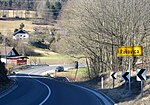Šmarjetna Gora
Pages with Slovene IPAPages with plain IPAPopulated places in the City Municipality of Kranj

Šmarjetna Gora (pronounced [ʃmaɾˈjeːtna ˈɡɔːɾa]; in older sources also Šent Marjetina Gora, German: Sankt Margarethen) is a former settlement in the Municipality of Kranj in the Upper Carniola region of Slovenia. Šmarjetna Gora was a dispersed settlement on the southern and eastern slopes of Mount Saint Margaret (Slovene: Šmarjetna gora) west of the Sava River. It is now part of the city of Kranj.
Excerpt from the Wikipedia article Šmarjetna Gora (License: CC BY-SA 3.0, Authors, Images).Šmarjetna Gora
Šmarjetna Gora, Kranj Stražišče
Geographical coordinates (GPS) Address Nearby Places Show on map
Geographical coordinates (GPS)
| Latitude | Longitude |
|---|---|
| N 46.241358333333 ° | E 14.335983333333 ° |
Address
Šmarjetna Gora
Šmarjetna Gora
4000 Kranj, Stražišče
Slovenia
Open on Google Maps











